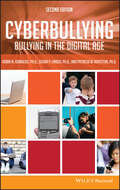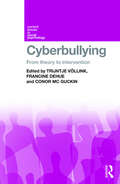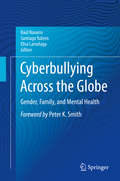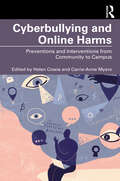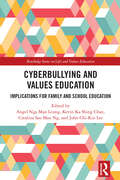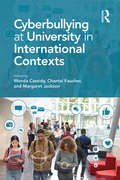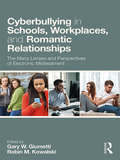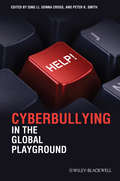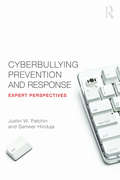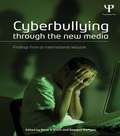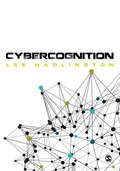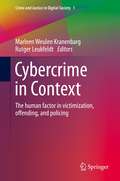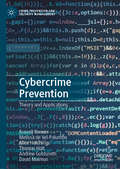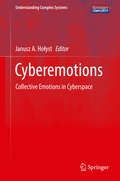- Table View
- List View
Cyberbullying: Bullying in the Digital Age
by Robin M. Kowalski Susan P. Limber Patricia W. AgatstonPsychologists explore the reality of cyberbullies Millions of children are affected by bullies each year. Advances in social media, email, instant messaging, and cell phones, however, have moved bullying from a schoolyard fear to a constant threat. The second edition of Cyberbullying offers the most current information on this constantly-evolving issue and outlines the unique concerns and challenges it raises for children, parents, and educators. Authored by psychologists who are internationally recognized as experts in this field, the text uses the latest research in this area to provide an updated, reliable text ideal for parents and educators concerned about the cyberbullying phenomenon.
Cyberbullying: From Theory to Intervention
by Trijntje Völlink Francine Dehue Conor Mc GuckinThe study of cyberbullying has exploded since its first appearance in a peer-reviewed journal article in 2005. Cyberbullying: From theory to intervention aims to make clear and practical sense of this proliferation of coverage by defining the problem of cyberbullying and examining its unique features. The volume provides a thorough overview of state-of-the-art research into the phenomenon, and discusses the development and evaluation of interventions to prevent and combat it. Whereas most research papers offer limited space to describe actual intervention methods, this book provides tremendous insight into the different theoretical methods and practical strategies available to combat cyberbullying. Part One provides readers with a critical review of the existing research literature and collects insights from international researchers involved in bullying and cyberbullying research, tackling key questions such as: how is cyberbullying defined, what is the overlap with traditional bullying, and what are the negative consequences of cyberbullying? Part Two gives an overview of the development and content of evidence-based ICT interventions aimed at preventing and combating bullying and cyberbullying. In addition, some of the important outcomes of the effect evaluations will be described. The book's final chapter integrates the information from Part One with advice regarding practical applications from Part Two. Cyberbullying: From theory to intervention is essential reading for academics and researchers concerned with both cyberbullying and traditional bullying. It can be used in graduate seminars or advanced undergraduate courses in cyberbullying and will also be of interest to teachers, field experts and organisations involved and disseminating cyberbullying solutions.
Cyberbullying: From Theory to Intervention (Bullying And Victimization Ser.)
by Trijntje Völlink Francine Dehue Conor Mc GuckinThe study of cyberbullying has exploded since its first appearance in a peer-reviewed journal article in 2005. Cyberbullying: From theory to intervention aims to make clear and practical sense of this proliferation of coverage by defining the problem of cyberbullying and examining its unique features. The volume provides a thorough overview of state-of-the-art research into the phenomenon, and discusses the development and evaluation of interventions to prevent and combat it. Whereas most research papers offer limited space to describe actual intervention methods, this book provides tremendous insight into the different theoretical methods and practical strategies available to combat cyberbullying. Part One provides readers with a critical review of the existing research literature and collects insights from international researchers involved in bullying and cyberbullying research, tackling key questions such as: how is cyberbullying defined, what is the overlap with traditional bullying, and what are the negative consequences of cyberbullying? Part Two gives an overview of the development and content of evidence-based ICT interventions aimed at preventing and combating bullying and cyberbullying. In addition, some of the important outcomes of the effect evaluations will be described. The book's final chapter integrates the information from Part One with advice regarding practical applications from Part Two. Cyberbullying: From theory to intervention is essential reading for academics and researchers concerned with both cyberbullying and traditional bullying. It can be used in graduate seminars or advanced undergraduate courses in cyberbullying and will also be of interest to teachers, field experts and organisations involved and disseminating cyberbullying solutions.
Cyberbullying Across the Globe: Gender, Family, and Mental Health
by Raúl Navarro Santiago Yubero Elisa LarrañagaThis book provides a much-needed analysis of the current research in the global epidemic of electronic bullying. Scholars and professionals from the Americas, Europe, and Asia offer data, insights, and solutions, acknowledging both the social psychology and technological contexts underlying cyberbullying phenomena. Contributors address questions that are just beginning to emerge as well as longstanding issues concerning family and gender dynamics, and provide evidence-based prevention and intervention strategies for school and home. The global nature of the book reflects not only the scope and severity of cyberbullying, but also the tenacity of efforts to control and eradicate the problem. Included in the coverage: • Gender issues and cyberbullying in children and adolescents: from gender differences to gender identity measures. • Family relationships and cyberbullying.• Examining the incremental impact of cyberbullying on outcomes over and above traditional bullying in North America.• A review of cyberbullying and education issues in Latin America.• Cyberbullying prevention from child and youth literature.• Cyberbullying and restorative justice. Cyberbullying across the Globe is an essential resource for researchers, graduate students, and other professionals in child and school psychology, public health, social work and counseling, educational policy, and family advocacy.
Cyberbullying and E-safety: What Educators and Other Professionals Need to Know
by Adrienne Katz"I'd die without my Blackberry" - one young person's comment sums up a generation of young people who are increasingly living their daily lives through their phones and the internet. Cyberbullying is rife, affecting one in five 10-19 year olds. It causes anxiety, unhappiness and mental health problems; in extreme cases even leading to suicide. This book provides a compelling and up to date account of the constantly evolving problem of cyberbullying: the different forms it can take, how the impact differs on boys and girls of different ages, and which children are most vulnerable. Drawing on the findings of the author's survey of over 9,000 children and teenagers, Cyberbullying and E-safety provides a revealing account of the direct experiences and views of children. It describes how a new world where emerging technologies such as smartphones have transformed online social behaviour requires a new, more relevant approach to e-safety and the problem of cyberbullying. The author provides this in the form of a youth-led, age- and gender-appropriate model for cyber-education in the modern world; a 3-tier model comprising universal e-safety education accompanied by targeted and intensive support and advice for children at most risk. She also outlines a school-wide model for preventing and responding to cyberbullying in children, young people and teachers, and provides a wealth of guidance and tools for individuals and schools including templates and lesson plans. Cyberbullying and E-safety is required reading for teachers, counsellors, youth workers, social workers, and other professionals working with children and young people.
Cyberbullying and E-safety: What Educators and Other Professionals Need to Know (PDF)
by Adrienne Katz“I'd die without my Blackberry” – one young person's comment sums up a generation of young people who are increasingly living their daily lives through their phones and the internet. Cyberbullying is rife, affecting one in five 10–19 year olds. It causes anxiety, unhappiness and mental health problems; in extreme cases even leading to suicide. This book provides a compelling and up to date account of the constantly evolving problem of cyberbullying: the different forms it can take, how the impact differs on boys and girls of different ages, and which children are most vulnerable. Drawing on the findings of the author's survey of over 9,000 children and teenagers, Cyberbullying and E-safety provides a revealing account of the direct experiences and views of children. It describes how a new world where emerging technologies such as smartphones have transformed online social behaviour requires a new, more relevant approach to e-safety and the problem of cyberbullying. The author provides this in the form of a youth-led, age- and gender-appropriate model for cyber-education in the modern world; a 3-tier model comprising universal e-safety education accompanied by targeted and intensive support and advice for children at most risk. She also outlines a school-wide model for preventing and responding to cyberbullying in children, young people and teachers, and provides a wealth of guidance and tools for individuals and schools including templates and lesson plans. Cyberbullying and E-safety is required reading for teachers, counsellors, youth workers, social workers, and other professionals working with children and young people.
Cyberbullying and Online Harms: Preventions and Interventions from Community to Campus
by Helen Cowie Carrie-Anne MyersCyberbullying and Online Harms identifies online harms and their impact on young people, from communities to campuses, exploring current and future interventions to reduce and prevent online harassment and aggression. This important resource brings together eminent international researchers whose work shines a light on social issues such as bullying/cyberbullying, racism, homophobia, hate crime, and social exclusion. The text collates into one volume current knowledge and evidence of cyberbullying and its effect on young people, facilitating action to protect victims, challenge perpetrators and develop policies and practices to change cultures that are discriminatory and divisive. It also provides a space where those who have suffered online harms and who have often been silenced in the past may have a voice in telling their experiences and recounting interventions and policies that helped them to create safer spaces in which to live in their community, study in their educational institutions and socialise with their peer group. This is essential reading for researchers, academics, undergraduates and postgraduates in sociology, psychology, criminology, media and communication studies, as well as practitioners and policymakers in psychology, education, sociology, criminology, psychiatry, counselling and psychotherapy, and anyone concerned with the issue of bullying, cyberbullying and online harms among young people in higher education.
Cyberbullying and Online Harms: Preventions and Interventions from Community to Campus
Cyberbullying and Online Harms identifies online harms and their impact on young people, from communities to campuses, exploring current and future interventions to reduce and prevent online harassment and aggression. This important resource brings together eminent international researchers whose work shines a light on social issues such as bullying/cyberbullying, racism, homophobia, hate crime, and social exclusion. The text collates into one volume current knowledge and evidence of cyberbullying and its effect on young people, facilitating action to protect victims, challenge perpetrators and develop policies and practices to change cultures that are discriminatory and divisive. It also provides a space where those who have suffered online harms and who have often been silenced in the past may have a voice in telling their experiences and recounting interventions and policies that helped them to create safer spaces in which to live in their community, study in their educational institutions and socialise with their peer group. This is essential reading for researchers, academics, undergraduates and postgraduates in sociology, psychology, criminology, media and communication studies, as well as practitioners and policymakers in psychology, education, sociology, criminology, psychiatry, counselling and psychotherapy, and anyone concerned with the issue of bullying, cyberbullying and online harms among young people in higher education.
Cyberbullying and Values Education: Implications for Family and School Education (Routledge Series on Life and Values Education)
by Angel Nga Man Leung Kevin Ka Shing Chan Catalina Sau Man Ng John Chi-Kin LeeWritten by scholars from both the Western and Chinese contexts, this monograph discusses the relation between cyberbullying and socio-emotional-moral competencies, feasible interventions by integrating values education, and provides future directions in the field of cyberpsychology. Cyberbullying has become a growing concern in the digital age as it brings devastating impacts on its victims. Educating the younger generation, particularly through values education, also known as character, moral, or social-emotional learning, helps equip children and adolescents with the necessary ethical and moral attitudes, and foster the necessary socio-emotional competencies for them to navigate the digital world as responsible cyber-citizens. A central focus of the book is intervention and education. Cultivating competences and responsible use of technology in the younger generation through values education and evidence-based intervention helps combat cyberbullying. Families, schools, and communities can work together with suitable school programs, teacher education, and parents/school collaboration to help students cope with cyberbullying and create safer online spaces for them. Technology itself is not inherently good or bad but shaped by human choices and values. Supported by empirical evidence and theoretical insights, this book suggests ways to promote moral and emotional skills, foster digital citizenship, and encourage ethical technology design. This book provides a comprehensive understanding of cyberbullying. This timely resource will contribute to creating a safer and more positive online environment for all. It will inform researchers, educators, parents, and the community in combating cyberbullying by enabling children and adolescents to be responsible, ethical, and happy netizens.
Cyberbullying and Values Education: Implications for Family and School Education (Routledge Series on Life and Values Education)
by Angel Nga Man Leung Kevin Ka Shing Chan Catalina Sau Man Ng John Chi-Kin LeeWritten by scholars from both the Western and Chinese contexts, this monograph discusses the relation between cyberbullying and socio-emotional-moral competencies, feasible interventions by integrating values education, and provides future directions in the field of cyberpsychology. Cyberbullying has become a growing concern in the digital age as it brings devastating impacts on its victims. Educating the younger generation, particularly through values education, also known as character, moral, or social-emotional learning, helps equip children and adolescents with the necessary ethical and moral attitudes, and foster the necessary socio-emotional competencies for them to navigate the digital world as responsible cyber-citizens. A central focus of the book is intervention and education. Cultivating competences and responsible use of technology in the younger generation through values education and evidence-based intervention helps combat cyberbullying. Families, schools, and communities can work together with suitable school programs, teacher education, and parents/school collaboration to help students cope with cyberbullying and create safer online spaces for them. Technology itself is not inherently good or bad but shaped by human choices and values. Supported by empirical evidence and theoretical insights, this book suggests ways to promote moral and emotional skills, foster digital citizenship, and encourage ethical technology design. This book provides a comprehensive understanding of cyberbullying. This timely resource will contribute to creating a safer and more positive online environment for all. It will inform researchers, educators, parents, and the community in combating cyberbullying by enabling children and adolescents to be responsible, ethical, and happy netizens.
Cyberbullying at University in International Contexts
by Wanda Cassidy Chantal Faucher Margaret JacksonCyberbullying is a problem that is being increasingly investigated by researchers, however, much of the cyberbullying research literature to date has focused on children and youth. Cyberbullying at University in International Contexts fills the gap in the research literature by examining the nature, extent, impacts, proposed solutions, and policy and practice considerations of bullying in the cyber-world at post-secondary institutions, where reports of serious cyberbullying incidents have become more prevalent. This book brings together cutting-edge research from around the world to examine the issue of cyberbullying through a multi-disciplinary lens, offering an array of approaches, interpretations, and solutions. It is not solely focused on cyberbullying by and against students, but also includes cyberbullying by and against faculty members, and permutations involving both students and faculty, as well as institutional staff, presenting perspectives from students, practitioners and senior university policy makers. It draws on research from education, criminology, psychology, sociology, communications, law, health sciences, social work, humanities, labour studies and is valuable reading for graduate students in these fields. It is also essential reading for policymakers, practitioners and University administrators who recognize their responsibility to provide a healthy workplace for their staff, as well as a safe and respectful environment for their students.
Cyberbullying at University in International Contexts
by Wanda Cassidy Chantal Faucher Margaret JacksonCyberbullying is a problem that is being increasingly investigated by researchers, however, much of the cyberbullying research literature to date has focused on children and youth. Cyberbullying at University in International Contexts fills the gap in the research literature by examining the nature, extent, impacts, proposed solutions, and policy and practice considerations of bullying in the cyber-world at post-secondary institutions, where reports of serious cyberbullying incidents have become more prevalent. This book brings together cutting-edge research from around the world to examine the issue of cyberbullying through a multi-disciplinary lens, offering an array of approaches, interpretations, and solutions. It is not solely focused on cyberbullying by and against students, but also includes cyberbullying by and against faculty members, and permutations involving both students and faculty, as well as institutional staff, presenting perspectives from students, practitioners and senior university policy makers. It draws on research from education, criminology, psychology, sociology, communications, law, health sciences, social work, humanities, labour studies and is valuable reading for graduate students in these fields. It is also essential reading for policymakers, practitioners and University administrators who recognize their responsibility to provide a healthy workplace for their staff, as well as a safe and respectful environment for their students.
Cyberbullying in Schools, Workplaces, and Romantic Relationships: The Many Lenses and Perspectives of Electronic Mistreatment
by Gary W. Giumetti Robin M. KowalskiThis volume brings together research on cyberbullying across contexts, age groups, and cultures to gain a fuller perspective of the prevalence and impact of electronic mistreatment on individual, group, and organizational outcomes. This is the first book to integrate research on cyberbullying across three contexts: schools, workplaces, and romantic relationships, providing a unique synthesis of lifespan contexts.For each context, the expert chapter authors bring together three different 'lenses': existing research on the predictors and outcomes of cyberbullying within that context; a cross-cultural review across national borders and cultural boundaries; and a developmental perspective that examines age-related differences in cyberbullying within that context. The book closes by drawing commonalities across these different contexts leading to a richer understanding of cyberbullying as a whole and some possible avenues for future research and practice.This is fascinating reading for researchers and upper-level students in social psychology, counseling, school psychology, industrial-organizational psychology, and developmental psychology, as well as educators and administrators.
Cyberbullying in Schools, Workplaces, and Romantic Relationships: The Many Lenses and Perspectives of Electronic Mistreatment
by Gary W. Giumetti Robin M. KowalskiThis volume brings together research on cyberbullying across contexts, age groups, and cultures to gain a fuller perspective of the prevalence and impact of electronic mistreatment on individual, group, and organizational outcomes. This is the first book to integrate research on cyberbullying across three contexts: schools, workplaces, and romantic relationships, providing a unique synthesis of lifespan contexts.For each context, the expert chapter authors bring together three different 'lenses': existing research on the predictors and outcomes of cyberbullying within that context; a cross-cultural review across national borders and cultural boundaries; and a developmental perspective that examines age-related differences in cyberbullying within that context. The book closes by drawing commonalities across these different contexts leading to a richer understanding of cyberbullying as a whole and some possible avenues for future research and practice.This is fascinating reading for researchers and upper-level students in social psychology, counseling, school psychology, industrial-organizational psychology, and developmental psychology, as well as educators and administrators.
Cyberbullying in the Global Playground: Research from International Perspectives
by Qing Li Donna Cross Peter K. SmithCyberbullying in the Global Playground provides the first global, in-depth analysis of the emerging phenomenon of cyberbullying. Offers the first thorough comparative account of recent research into the emerging global phenomenon of cyberbullying Provides an international perspective on the prevalence and nature of cyberbullying Presents recent authoritative research within a critical perspective, drawing out theoretical and practical implications for policy and practice May be used to help design intervention, evaluation, and policy strategies for effective efforts to combat the international phenomenon of cyberbullying
Cyberbullying in the Global Playground: Research from International Perspectives
by Qing Li Donna Cross Peter K. SmithCyberbullying in the Global Playground provides the first global, in-depth analysis of the emerging phenomenon of cyberbullying. Offers the first thorough comparative account of recent research into the emerging global phenomenon of cyberbullying Provides an international perspective on the prevalence and nature of cyberbullying Presents recent authoritative research within a critical perspective, drawing out theoretical and practical implications for policy and practice May be used to help design intervention, evaluation, and policy strategies for effective efforts to combat the international phenomenon of cyberbullying
Cyberbullying Prevention and Response: Expert Perspectives
by Justin W. Patchin Sameer HindujaJust as the previous generation was raised in front of televisions, adolescents at the turn of the 21st century are being raised in an internet-enabled world where blogs, social networking, and instant messaging are competing with face-to-face and telephone communication as the dominant means through which personal interaction takes place. Unfortunately, a small but growing proportion of our youth are being exposed online to interpersonal violence, aggression, and harassment via cyberbullying. The mission of this book is to explore the many critical issues surrounding this new phenomenon. Key features include the following. Comprehensive – The book provides a comprehensive, up-to-date look at the major issues that teachers, school administrators, counsellors, social workers, and parents need to be aware of with respect to cyberbullying identification, prevention, and response. Practical – While the information is informed by research, it is written in an accessible way that all adults will be able to understand and apply. Expertise – Justin W. Patchin and Sameer Hinduja are Co-Directors of the Cyberbullying Research Center (www.cyberbullying.us). Chapter authors represent a carefully selected group of contributors who have demonstrated both topical expertise and an ability to write about the topic in clear, easily accessible language. This book is appropriate for teachers, administrators, parents and others seeking research-based guidance on how to deal with the rising tide of cyberbullying issues. It is also appropriate for a variety of college level courses dealing with school violence and educational administration.
Cyberbullying Prevention and Response: Expert Perspectives
by Justin W. Patchin Sameer HindujaJust as the previous generation was raised in front of televisions, adolescents at the turn of the 21st century are being raised in an internet-enabled world where blogs, social networking, and instant messaging are competing with face-to-face and telephone communication as the dominant means through which personal interaction takes place. Unfortunately, a small but growing proportion of our youth are being exposed online to interpersonal violence, aggression, and harassment via cyberbullying. The mission of this book is to explore the many critical issues surrounding this new phenomenon. Key features include the following. Comprehensive – The book provides a comprehensive, up-to-date look at the major issues that teachers, school administrators, counsellors, social workers, and parents need to be aware of with respect to cyberbullying identification, prevention, and response. Practical – While the information is informed by research, it is written in an accessible way that all adults will be able to understand and apply. Expertise – Justin W. Patchin and Sameer Hinduja are Co-Directors of the Cyberbullying Research Center (www.cyberbullying.us). Chapter authors represent a carefully selected group of contributors who have demonstrated both topical expertise and an ability to write about the topic in clear, easily accessible language. This book is appropriate for teachers, administrators, parents and others seeking research-based guidance on how to deal with the rising tide of cyberbullying issues. It is also appropriate for a variety of college level courses dealing with school violence and educational administration.
Cyberbullying through the New Media: Findings from an international network
by Peter K. Smith Georges SteffgenCyberbullying is one of the darker and more troubling aspects to the growing accessibility of new media technologies. Children in developed countries engage with cyberspace at younger and younger ages, and the use of the internet as a means to bully and harass has been greeted with alarm by educationalists, parents, the media, and governments. This important new book is the result of a four-year international collaboration, funded by the EU, to better understand how we can cope and confront cyberbullying, and how new media technologies can be used to actually support the victims of such abuse. The articles initially define the historical and theoretical context to cyberbullying, before examining key issues involved in managing this pervasive phenomenon. Coverage includes: The definition and measurement of cyberbullying. The legal challenges in tackling cyberbullying across a number of international contexts. The role of mobile phone companies and Internet service providers in monitoring and prevention How the media frame and present the issue, and how that influences our understanding. How victims can cope with the effects of cyberbullying, and the guidelines and advice provided in different countries. How cyber-bullying can continue from school into further education, and the strategies that can be used to prevent it. The ways in which accessing 'youth voice', or maximising the contribution of young people themselves to the research process, can enhance our understanding The book concludes with practical guidance to help confront the trauma that cyberbullying can cause. It will be a valuable resource for researchers, students, policy makers and administrators with an interest in how children and young people are rendered vulnerable to bullying and harassment through a variety of online channels.
Cyberbullying through the New Media: Findings from an international network
by Peter K. Smith Georges SteffgenCyberbullying is one of the darker and more troubling aspects to the growing accessibility of new media technologies. Children in developed countries engage with cyberspace at younger and younger ages, and the use of the internet as a means to bully and harass has been greeted with alarm by educationalists, parents, the media, and governments. This important new book is the result of a four-year international collaboration, funded by the EU, to better understand how we can cope and confront cyberbullying, and how new media technologies can be used to actually support the victims of such abuse. The articles initially define the historical and theoretical context to cyberbullying, before examining key issues involved in managing this pervasive phenomenon. Coverage includes: The definition and measurement of cyberbullying. The legal challenges in tackling cyberbullying across a number of international contexts. The role of mobile phone companies and Internet service providers in monitoring and prevention How the media frame and present the issue, and how that influences our understanding. How victims can cope with the effects of cyberbullying, and the guidelines and advice provided in different countries. How cyber-bullying can continue from school into further education, and the strategies that can be used to prevent it. The ways in which accessing 'youth voice', or maximising the contribution of young people themselves to the research process, can enhance our understanding The book concludes with practical guidance to help confront the trauma that cyberbullying can cause. It will be a valuable resource for researchers, students, policy makers and administrators with an interest in how children and young people are rendered vulnerable to bullying and harassment through a variety of online channels.
Cybercognition: Brain, behaviour and the digital world (PDF)
by Dr Lee HadlingtonTechnology is developing rapidly. It is an essential part of how we live our daily lives – in a mental and physical sense, and in professional and personal environments. Cybercognition explores the ideas of technology addiction, brain training and much more, and will provide students with a guide to understanding concepts related to the online world. It answers important questions: What is the impact of digital technology on our learning, memory, attention, problem-solving and decision making? If we continue to use digital technology on a large scale, can it change the way we think? Can human cognition keep up with technology? Suitable for students on Cyberpsychology and Cognitive Psychology courses at all levels, as well as anyone with an inquiring mind.
Cybercognition: Brain, behaviour and the digital world
by Dr Lee HadlingtonTechnology is developing rapidly. It is an essential part of how we live our daily lives – in a mental and physical sense, and in professional and personal environments. Cybercognition explores the ideas of technology addiction, brain training and much more, and will provide students with a guide to understanding concepts related to the online world. It answers important questions: What is the impact of digital technology on our learning, memory, attention, problem-solving and decision making? If we continue to use digital technology on a large scale, can it change the way we think? Can human cognition keep up with technology? Suitable for students on Cyberpsychology and Cognitive Psychology courses at all levels, as well as anyone with an inquiring mind.
Cybercrime in Context: The human factor in victimization, offending, and policing (Crime and Justice in Digital Society #I)
by Rutger Leukfeldt Marleen Weulen KranenbargThis book is about the human factor in cybercrime: its offenders, victims and parties involved in tackling cybercrime. It takes a diverse international perspective of the response to and prevention of cybercrime by seeking to understand not just the technological, but the human decision-making involved. This edited volume represents the state of the art of research on the human factor in cybercrime, addressing its victims, offenders, and policing. It originated at the Second annual Conference on the Human Factor in Cybercrime, held in The Netherlands in October 2019, bringing together empirical research from a variety of disciplines, and theoretical and methodological approaches. This volume will be of particular interest to researchers and students in cybercrime and the psychology of cybercrime, as well as policy makers and law enforcement interested in prevention and detection.
Cybercrime Prevention: Theory and Applications (Crime Prevention and Security Management)
by Russell Brewer Melissa de Vel-Palumbo Alice Hutchings Thomas Holt Andrew Goldsmith David MaimonThis book articulates how crime prevention research and practice can be reimagined for an increasingly digital world. This ground-breaking work explores how criminology can apply longstanding, traditional crime prevention techniques to the digital realm. It provides an overview of the key principles, concepts and research literature associated with crime prevention, and discusses the interventions most commonly applied to crime problems. The authors review the theoretical underpinnings of these and analyses evidence for their efficacy. Cybercrime Prevention is split into three sections which examine primary prevention, secondary prevention and tertiary prevention. It provides a thorough discussion of what works and what does not, and offers a formulaic account of how traditional crime prevention interventions can be reimagined to apply to the digital realm.
Cyberemotions: Collective Emotions in Cyberspace (Understanding Complex Systems)
by Janusz A. HolystThis first monograph of its kind introduces the reader to fundamental definitions, key concepts and case studies addressing the following issues of rapidly growing relevance for online communities: What are emotions? How do they emerge, how are they transmitted? How can one measure emotional states? What are cyberemotions? When do emotions and cyberemotions become collective phenomena? How can one model emotions and their changes? What role do emotions play for on-line communities?Edited and authored by leading scientists in this field, this book is a comprehensive reference for anyone working on applications of complex systems methods in the social sciences, as well as for social scientists, psychologists, experts in on-line communities and computer scientists.This book provides an excellent overview of the current state-of-art in research on collective emotional interactions mediated by the Internet. It introduces a reader in social phenomena occurring in cyberspace, algorithms needed for automatic sentiment detection and data driven modeling of emotional patterns observed in on-line groups.Eugene Stanley, Professor, Boston UniversityWith the explosive hyper-exponential growth of the internet suddenly new ways of communication are emerging that give rise to a digital 'Homo empathicus', each of us suddenly being able to share thoughts and feelings with millions if not billions of others. This book is a true treat, a timely milestone that gives us insight in the co-evolution of the way we interact with each other and the communication technology provided through this new seemingly endless flexible digital world. Prof. Holyst did a great job bringing together real experts in the field of cyber emotions.Peter M.A. Sloot, Professor, University of Amsterdam, the Netherlands, Nanyang University, SingaporeThe book Cyberemotions embraces the topic of emotion studies in cyberspace from a very rich spectrum of points of view and applications. It is particularly interesting reading the theoretical foundations underlying the concepts of cyberemotions and how these concepts can be captured, modeled and implemented in real-time applications.Catherine Pelachaud, Director of Research CNRS at LTCI, TELECOM ParisTechLogical machines give us a chance to analyze our often illogical behaviors, especially in the vast meadows of the cyberspace. In this important book, authors of different backgrounds present a wide and deep image, not only of methods of analyzing our emotional behavior online but also how the computers can help to break communicational walls the same technology had built.Rafal Rzepka, Professor, Hokkaido University
